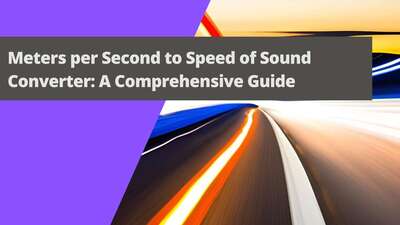Meters per Second to Speed of Sound Converter: A Comprehensive Guide

- Introduction
- Definition
- Formula
- Explaining Conversion Factors and Table
- Step-by-Step Guide
- Real-world Examples and Applications
- Frequently Asked Questions
- What is the speed of sound in air?
- What is the Mach number?
- Can I use the same formula for different mediums?
- Where can I find a reliable meters per second to speed of sound converter?
- Are there any resources to learn more about speed conversions?
- Conclusion
In this comprehensive guide, we will discuss everything you need to know about converting meters per second to the speed of sound. This conversion is essential for various applications in science, engineering, and daily life. We will cover the definition, formula, conversion factors, and provide a step-by-step guide with real-world examples and applications. Additionally, we will answer some frequently asked questions related to this topic. So, let's dive in!
Introduction
Speed is a crucial concept in physics, and it is often necessary to convert between different units of speed. One such conversion is between meters per second (m/s) and the speed of sound. The speed of sound varies with the medium it is traveling through, and it is typically measured in Mach numbers. By using a meters per second to speed of sound sound converter, you can easily convert these units for practical applications.
Definition
The speed of sound is the rate at which sound waves travel through a medium, like air or water. It depends on the medium's properties, such as its density and elasticity. In air, the speed of sound is approximately 343 meters per second at sea level and 20°C. The meters per second unit is a commonly used unit for measuring speed and is defined as the distance covered per unit of time in meters and seconds, respectively.
Formula
To convert between meters per second and the speed of sound, you need the following formula:
Mach = (m/s) / (speed of sound in m/s)
Where Mach is the Mach number, m/s is the speed in meters per second, and the speed of sound in m/s is typically 343 meters per second for air at sea level and 20°C. This formula will help you convert any speed given in meters per second to the equivalent speed of sound (Mach number).
Explaining Conversion Factors and Table
There are various factors that can influence the speed of sound, such as temperature, humidity, and altitude. To account for these factors, you can use conversion factors based on the specific conditions of the medium. These factors will help you adjust the speed of sound value in the formula mentioned above, allowing for more accurate conversions.
Here is a table showing the speed of sound in air at various temperatures:
| Temperature (°C) | Speed of Sound (m/s) |
|---|---|
| -10 | 325 |
| 0 | 331 |
| 10 | 337 |
| 20 | 343 |
| 30 | 349 |
| 40 | 355 |
This table can be used as a reference to adjust the speed of sound value in the conversion formula based on the temperature of the medium.
Step-by-Step Guide
Follow these steps to convert meters per second to the speed of sound:
- Identify the speed in meters per second that you want to convert.
- Consider the medium and its properties, such as temperature, to determine the appropriate speed of sound value.
- Use the conversion formula: Mach = (m/s) / (speed of sound in m/s).
- Calculate the Mach number using the values obtained in steps 1-3.
By following these steps, you can easily convert any speed given in meters per second to the equivalent speed of sound (Mach number).
Real-world Examples and Applications
Converting meters per second to the speed of sound is important in various fields, such as:
- Aeronautics: To determine the speed of aircraft in Mach numbers and analyze their performance.
- Meteorology: To study the propagation of sound waves in the atmosphere and predict weather patterns.
- Acoustics: To analyze the behavior of sound waves in different environments and design audio systems.
- Engineering: To assess the performance of engines, turbines, and other machines that produce sound waves.
By using a speed converter and following the conversion steps outlined in this guide, you can effectively apply these concepts in real-world situations.
Frequently Asked Questions
What is the speed of sound in air?
The speed of sound in air varies depending on factors such as temperature, humidity, and altitude. At sea level and 20°C, the speed of sound in air is approximately 343 meters per second.
What is the Mach number?
The Mach number is a dimensionless quantity that represents the ratio of an object's speed to the speed of sound in a given medium. It is used to express the speed of objects like aircraft in relation to the speed of sound.
Can I use the same formula for different mediums?
Yes, you can use the same conversion formula for different mediums, but you need to adjust the speed of sound value according to the specific medium's properties, such as its density and elasticity. For example, the speed of sound in water is approximately 1,480 meters per second, which is much higher than in air. Therefore, when converting meters per second to the speed of sound in water, you need to use the appropriate speed of sound value for the medium in the formula.
Where can I find a reliable meters per second to speed of sound converter?
You can find a reliable meters per second to speed of sound converter at Amazing Converter. The website offers a user-friendly interface and accurate conversions based on the medium's properties.
Are there any resources to learn more about speed conversions?
Yes, there are numerous resources available online to learn more about speed conversions. One excellent resource is this YouTube playlist, which covers various topics related to speed conversions and their applications.
Conclusion
Understanding how to convert meters per second to the speed of sound is essential for various applications in science, engineering, and daily life. By following the steps outlined in this guide, you can easily perform this conversion using the appropriate formula and conversion factors. Additionally, by exploring the real-world examples and applications, you can gain a deeper understanding of the importance of this conversion in various fields. Finally, don't forget to check out the resources provided in this guide, such as the speed converter and YouTube playlist, to further enhance your knowledge and skills.









